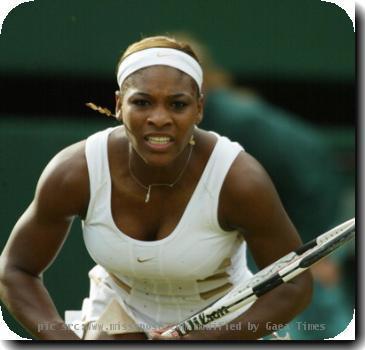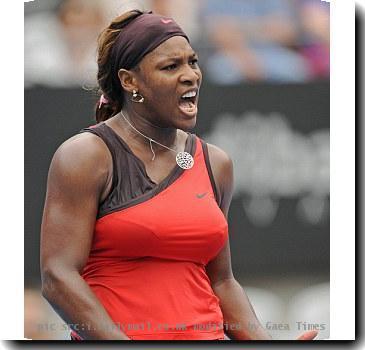Brava! Schiavone beats Stosur at French Open to give Italy its 1st female Grand Slam champion
By Howard Fendrich, APSaturday, June 5, 2010
Italy’s Schiavone beats Stosur to win French Open
PARIS — For more than a decade as a professional tennis player, and nearly 30 years as a person, Francesca Schiavone waited and worked to reach this particular moment on this particular court, and there was no way she was going to conceal her excitement about arriving.
As Schiavone moved closer, point by important point, to winning the French Open title, and to giving Italy its first female champion at a Grand Slam tournament, she let everyone watching share in the sheer joy.
At 2-all in the second-set tiebreaker of Saturday’s taut final against Samantha Stosur of Australia, Schiavone hit a forehand volley winner and raised a fist, well aware she was four points from victory.
Schiavone next smacked a volley to end a nine-stroke exchange and jumped to celebrate. Three points away. A forehand winner followed, and Schiavone screamed. Two points away. She slid through the red clay and, lunging, poked yet another volley winner. She yelled again, hopping in place. One point away.
And then, after delivering a spin-laden backhand from the baseline, Schiavone watched the ball glance off Stosur’s racket frame and deflect harmlessly in the wrong direction. Zero points away. The 17th-seeded Schiavone covered her face with both hands, then dropped to the ground and stayed on her back for a few moments, smearing her white outfit with rust-colored clay, relishing the 6-4, 7-6 (2) win over the No. 7-seeded Stosur and the many, little steps that brought her there, right where she always believed she could be.
Schiavone (pronounced Skee-ah-VOH-nay) curled over and kissed the court, giving thanks to “this clay, this beautiful tournament and this arena,” as she put it later, for giving her “this opportunity and all the emotion that I am living.”
She turns 30 this month, making her the oldest woman since 1969 to win her first Grand Slam championship. On Monday, Schiavone will rise to a career-best No. 6 in the WTA rankings, making her the oldest woman since 1998 to make her top-10 debut.
Consider how far she’s come in only 12 months: At the 2009 French Open, Schiavone was ranked 50th and lost in the first round against — you guessed it — Stosur.
“When you achieve goals with self-awareness, by working on who you are and what you do every day of your life, you’re able to appreciate it much more,” she said in Italian. “I finally was ready to win this trophy.”
Both she and those around her say the way Schiavone has grown as a person off the court in recent years helps her perform better on the court. She never had been past the quarterfinals at 38 previous major tournaments and had won only three titles anywhere.
“I wasn’t like this 10 years ago. They know,” she said, nodding toward Italian journalists who’ve tracked her career. “I decided to express myself, to be free, to be able to share my joy. Why not? When you give, you also can receive. If you remain closed, there’s no exchange. I love to exchange. I love to give.”
As far as tennis goes, it clearly also helps to have a concrete game plan and follow it perfectly, something Schiavone did against Stosur, who upset current No. 1 Serena Williams and past No. 1s Justine Henin and Jelena Jankovic en route to Saturday.
“You want the full fairy tale,” Stosur said, her voice cracking, “but it didn’t quite happen.”
Not for her. But it did for Schiavone, who mixed speeds, went after Stosur’s weaker backhand side, made sure to put the Australian’s powerful serves in play, and pushed forward perfectly, winning 14 of the 15 points when she went to the net.
“I still don’t think I played that bad. She just had her day. She went for it, and everything came off,” Stosur said. “It takes guts to do that.”
Neither of Saturday’s participants played in a Grand Slam singles final before — only the fifth such matchup in the 42-year Open era — and everything was new.
“It was a big occasion,” Stosur said, “and you never really know how you’re going to react.”
When they stepped on court, sun blazing and the temperature on its way to 86 degrees, Stosur wasn’t quite sure what to do with the pastel-colored flowers she was handed. She placed them on her green changeover bench before a ballkid removed the bouquet and put it on the ground, leaving her space to sit.
During the prematch photo op at the net following the coin toss, Schiavone and Stosur posed together briefly, then started to walk away before being reminded to rotate and face the other side of the court to oblige other cameras.
Once play began, though, all came much easier for both women. They produced big strokes and nearly even, entertaining action, prompting 18-time Grand Slam singles champion Martina Navratilova to gush, “It’s nice to see two creative players make it to the final and then play a good final.”
The first service break of the match came a half-hour in, at 4-all. After saving two break points, Stosur faltered on the third, double-faulting to hand Schiavone a 5-4 edge. Stosur slapped her right thigh with her palm and dumped her racket on the sideline.
Schiavone then served out the set, which ended with Stosur dumping a backhand into the net. With that, Schiavone leaped and skipped to the changeover, while her loud cheering section rose, shouting while some waved a red-white-and-green Italian flag with a diminutive form of her first name, “Franci,” printed in black block letters. A group of about 30 friends made the trek from Italy, some leaving at 3 a.m. Saturday to catch a flight. They wore black T-shirts printed hastily Friday with a childhood nickname, “Schiavo,” in yellow, and “Nothing is impossible,” in white. Later, they marched outside, chanting her name — “Fran-CHESS-skah!” — during Schiavone’s postmatch news conference, cracking her concentration and drawing a smile while she spoke in English.
Schiavone’s only real wobble came when Stosur finally earned her first break point, after an hour. Stosur went up 3-1 in the second set, then held to 4-1.
“I was a little worried,” said Italy’s Fed Cup and Davis Cup captain Corrado Barazzutti, who works with Schiavone in lieu of a full-time, personal coach.
But Stosur’s coach, Australia’s Fed Cup captain David Taylor, said of his charge: “She got very passive then, and she’ll look back on that and regret that moment.”
Indeed, Schiavone reeled off the next three games to get to 4-all. A series of holds led to the tiebreaker, which was tied before Schiavone took the last five points, full of emotion all the way.
“I felt an energy from inside that I couldn’t even control. It was so big. And to tell the truth, I still have it,” she said, more than two hours after the match’s conclusion. “I could go run 20 kilometers (12 miles) to get it out of my system.”
Said Navratilova, admiringly: “The passion came through. She wanted it. She wanted it, badly. She was going to die on that court if she had to.”
During the on-court ceremony, Schiavone took a congratulatory call from Italian President Giorgio Napolitano, and also spoke on a cell phone with her parents, who get too wound up watching her play, so remained home in Milan.
As a kid, Schiavone plastered her bedroom walls with posters — long since removed — of her favorite tennis players: Navratilova, Steffi Graf, Monica Seles, Pete Sampras.
All Grand Slam champions.
Now, so many years later, Schiavone is a Grand Slam champion, too, and she joked Saturday that now perhaps she should put up a poster of herself.
“Everybody has the chance to be who you really want to be, and do everything in your life,” Schiavone said. “This is what has happened to me.”
Tags: Australia, Australia And Oceania, Europe, Events, Francesca schiavone, French Open Tennis Championship, Italy, Paris, Samantha Stosur, Serena williams, Sports, Western Europe, Women's Sports, Women's Tennis

